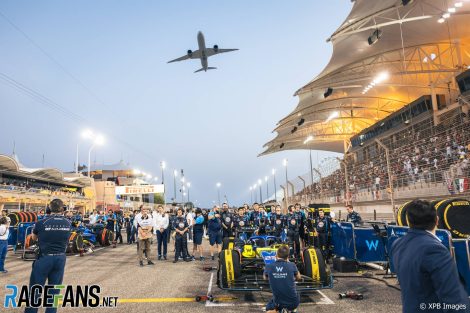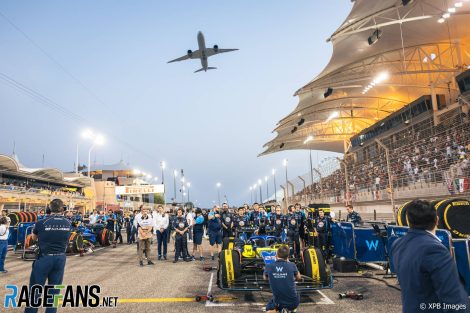Formula 1’s sustainability drive has led to the development of new sustainable fuels for the race cars, made possible by breakthroughs in carbon capture technology. The new fuel is created from renewable energy, hydrogen, and carbon, which is taken from the air, rather than by burning fossil fuels, resulting in a lower carbon footprint. F1’s Chief Technical Officer Pat Symonds believes that the new fuel can be produced sustainably without affecting food production. However, there are still challenges to overcome, such as finding ways to produce carbon-neutral fuels at scale and reducing the cost of carbon capture. Symonds believes that direct carbon capture technology, while still in its formative stages, has a lot going for it and that the costs are coming down dramatically as was the case with wind and solar energy. The new fuels produced from this technology have lower energy density, so hydrogen is needed to increase the energy content, but these fuels are expected to be much cheaper in the long run.
Formula 1 is committed to using 100% sustainably-sourced fuel in all cars by 2026, and currently four companies supply the fuel to the 20-car grid. Furthermore, more companies are working with the world championship on its future fuel regulations. ExxonMobil supplies Red Bull and AlphaTauri, with the latter sponsored by Mobil’s Polish trading partner PKN Orlen. Petronas products are used in all Mercedes-powered cars, while Alpine uses fuel from BP subsidiary Castrol, and all Ferrari-powered cars use Shell. Aston Martin’s title sponsor, Aramco, is the fuel supplier for Formula 2 and Formula 3 championships this year with a “55% sustainable” fuel, and is working with F1 on its sustainability target. F1’s chief technology officer, Pat Symonds, explained that the new fuels will be hydrocarbon-based mixes, and the key to a fuel being sustainable is that its elements come from sustainable sources. The hydrogen comes from the electrolysis of water, and the carbon will be sourced from plants, algae, or direct air capture, which is a difficult technology to scale up. This new process of carbon sourcing will contribute to the science and art of making the technology more sustainable across all applications.
Formula 1 is planning to use 100% sustainably sourced fuel in all cars by 2026, with four companies already supplying the fuel to the 20-car grid. In addition, more companies are currently working with F1 on its future fuel regulations. ExxonMobil provides fuel to Red Bull and AlphaTauri, with the latter sponsored by Mobil’s Polish trading partner PKN Orlen. All Mercedes-powered cars use Petronas products, while Alpine uses fuel from BP subsidiary Castrol, and all Ferrari-powered cars use Shell. Aramco, Aston Martin’s title sponsor, is the fuel supplier for Formula 2 and Formula 3 championships this year with a “55% sustainable” fuel and is working with F1 on its sustainability target.
According to Pat Symonds, F1’s chief technology officer, the new fuels will be hydrocarbon-based mixes, with sustainable elements sourced from hydrogen and carbon. The hydrogen will come from the electrolysis of water, and the carbon will be sourced sustainably from plants, algae, or direct air capture. However, the technology for direct air capture is difficult to scale up. The carbon and hydrogen sourced sustainably can make the fuel carbon-neutral, but the manufacturing and transport processes need to be taken into account as well.
The 2026 fossil fuel ban for F1 currently only applies to cars racing on the track. The total carbon footprint of F1 as a sport is slightly over a quarter of a million tonnes, with running cars around the track representing just 0.7% of that. A carbon-neutral future is as realistic for F1 as it is for road cars. According to Symonds, “We get just as much power from [sustainable fuel] as we can from standard, fossil gasoline.”

Symonds emphasized that fuel generation must not compete with food production, and the regulations have been carefully designed to promote different methods of producing sustainable fuels. One example of the attention given to the rules is a change in how the fuel consumption rate will be measured from 2026. Rather than regulating the mass of fuel that goes into the engine, F1 will regulate the flow of 3,000 megajoules of fuel per hour, which is around three-quarters of the current energy content. This is because of an increase in hybridization and electrical power in the cars.
The feeder series of F1 are being used as a testing ground to develop new sustainable fuels. With the regulations carefully designed to promote competition among different methods of producing sustainable fuels, no one is yet sure which method is the best. The focus is on developing fuels from non-food bio sources, municipal waste, carbon capture, and any method that does not compete with food sources. The strapline for F1’s fuel production is “you can make this fuel out of potato peelings, but not out of potatoes.”
According to Pat Symonds, F1’s chief technology officer, creating the new fuel is an energy-intensive process, and there is a term called EROI (energy return on investment) which is one of the fundamentals of it. The fuel production process uses around six times the energy contained in the fuel it produces. This means that to produce a kilogram of fuel that has 43 megajoules of energy, around 240 megajoules of energy is required. However, if the energy used in production is renewable, this can be considered a stage one solution. Symonds emphasizes that everything related to carbon reduction relies on an abundance of renewable electricity.
F1 wants to use the direct carbon capture technique to create sustainable fuel, which cuts out the middleman in harnessing carbon. Although this technique has a lot going for it, it is still in its formative stages, and the scalability is yet to be proven. This technique can reduce the timescale, as it doesn’t require biological carbon capture, which involves growing trees, plants, or algae.
Aramco, F1’s fuel supplier for the feeder series, is a big believer in carbon capture and has announced a project to capture nine million tonnes of CO₂ a year from industrial sources. Ahmad Al-Khowaiter, Aramco’s chief technical officer, says that the bigger challenge is capturing carbon from the air. The technology for direct air capture is still immature, but Aramco is investing heavily in that area. Many technologies are being developed to bring the cost of carbon capture down to more reasonable costs.
The energy return on investment is fundamental to creating sustainable fuel, and an abundance of renewable electricity is necessary for carbon reduction. F1 plans to use the direct carbon capture technique to create sustainable fuel, but this technology is still in its formative stages. Aramco is investing heavily in carbon capture, and the bigger challenge is capturing carbon from the air. The technology is still immature, but many projects are being developed to bring the cost of carbon capture down to more reasonable costs.
Direct Carbon Capture and the Future of F1 Fuel
Formula 1 is on a mission to reduce its carbon footprint and is investing heavily in the development of a synthetic fuel that can reduce its environmental impact. However, creating this new fuel is an energy-intensive process that requires a lot of renewable electricity.
The F1 industry is looking to create a synthetic fuel that is carbon-neutral and can be produced sustainably from non-food bio sources, municipal waste, and carbon capture. However, the process currently uses six times the energy contained in the fuel it produces, which is a significant issue that needs to be addressed.
Despite the challenges, F1 remains optimistic that synthetic fuel can become a reality. It can deliver as much power as standard fossil gasoline, and F1’s 2026 fossil fuel ban currently only applies to the cars racing on the track. According to Pat Symonds, F1’s Chief Technical Officer, the sport’s total carbon footprint is just over a quarter of a million tonnes per year. Of that, the amount represented by running F1 cars around the track is only 0.7%, a very small amount indeed.
The real value of synthetic fuel comes from the hydrogen that is produced through renewable energy. The CO₂, or carbon, is a carrier in many ways, as it brings in low energy-carbon that doesn’t have much energy. It’s the hydrogen that adds the energy into the carbon and gives you the fuel ultimately. The carbon is necessary to carry the energy because it gives you that energy density.
The direct carbon capture technique that F1 wants to use to harness carbon is still a technology in its formative stages. The technique reduces the time scale because it cuts out the middleman in capturing carbon. However, the scalability of the technique is still to be proven.
The cost of direct carbon capture is currently high, ranging from $400 to $800 per tonne, which would translate to roughly $200 to $300 a barrel of oil. However, the costs are expected to come down dramatically, as seen in wind and solar technologies. The learning curve of the technology will drive down costs to much more reasonable and practical levels.
The F1 industry understands that fuel generation must not take over from food production. It needs to create a sustainable fuel that doesn’t compete for land use. F1 is promoting different methods of producing synthetic fuel, but it’s still not sure which method is the best. Therefore, the rules for producing synthetic fuel have been written very carefully to promote competition without producing a runaway fuel.
F1 is looking to the future, where it can create a carbon-neutral fuel that is sustainable and can be produced at scale. Direct carbon capture is one way to harness carbon and bring down costs. Creating a synthetic fuel that delivers the same power as standard fossil gasoline will be a significant scientific achievement, and F1 is committed to being at the forefront of this new technology.
Don’t miss interesting posts on Famousbio










